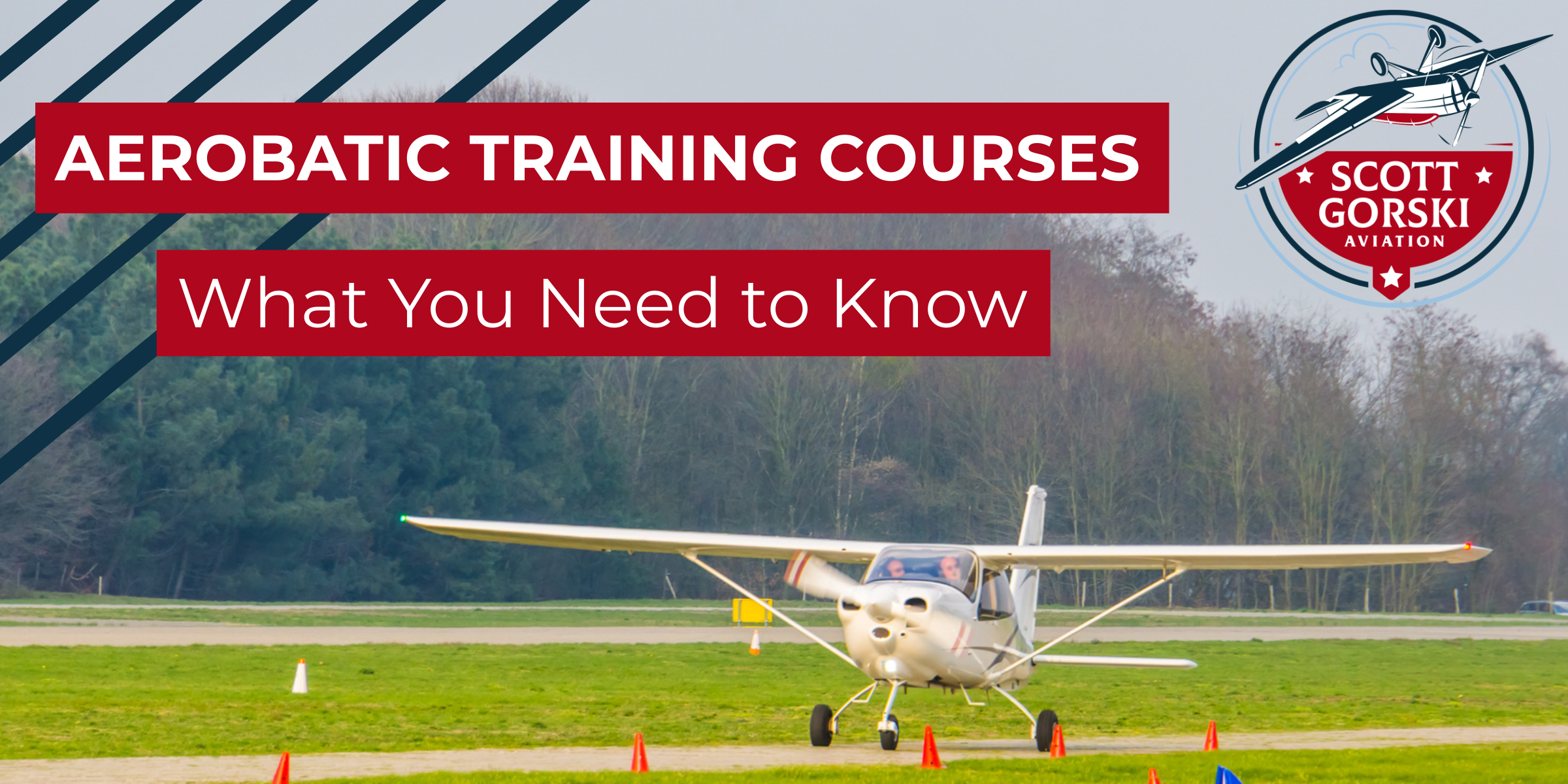Aerobatic Flight Training Courses in Seattle – What You Need to Know

Welcome to an exhilarating world of aerobatic flight training programs in Seattle, where aspiring aerobatic pilots and thrill-seekers alike can experience the adrenaline rush of performing daring maneuvers. Washington State and the Seattle area boast some of the best aerobatic flight schools in the United States, offering top-notch training programs with expert instruction. Whether you dream of becoming a skilled aerobatic performer or simply wish to further refine your piloting skills, these specialized programs are designed to cater to all levels of experience and passion for flight. Learn more about Scott Gorski, your certified aerobatic flight trainer, and join us as we take an overview of his numerous aerobatic flight training programs.
Understanding Aerobatic Flight: Exploring the Importance Of Aerobatic Flying in Pilot Training
Aerobatic flight is a specialized aspect of aviation that focuses on performing precise and daring maneuvers in the air. Within the industry, it can also be referred to as acro. It requires exceptional skill, precision, and a deep understanding of aircraft dynamics. Exploring the fundamentals of aerobatic flying is crucial for pilots as it enhances their overall proficiency and control in the cockpit. One key component of aerobatic flight training is mastering the three axes of movement: pitch, roll, and yaw. Pilots learn how to manipulate these movements to execute various aerobatic maneuvers such as loops, rolls, spins, and stalls. Understanding how an aircraft responds to different inputs during extreme maneuvers is vital to ensure safety while pushing the limits.
Moreover, learning aerobatics contributes to enhanced situational awareness skills and decision-making abilities under high-stress situations. Aerobatic flight develops confidence in handling unpredictable scenarios that can occur during regular flights or emergency situations. By experiencing controlled spins or inverted flight during training programs, pilots gain vital experience that can be applied when faced with unexpected events in real-world flying. Scott Gorski’s reputation for having one of the best aerobatic flight schools in the Seattle Area underscores his commitment to providing top-notch instruction in this exciting field. These programs offer a range of courses tailored for both beginners looking to enter the world of flight aerobatics and experienced aviators wanting to refine their skills further. Aerobatic flight training not only offers an adrenaline rush but also instills discipline, precision, and improved techniques essential for becoming a well-rounded pilot.
What is CFI Spin Training, and Why Is It Important For Every Pilot To Learn?
CFI spin training, also known as Certified Flight Instructor spin training, is a type of flight instruction that focuses on teaching pilots how to recognize, recover from, and avoid dangerous spins. A spin occurs when an aircraft enters an unstable flight condition, causing it to stall and rotate simultaneously. It is essential for every pilot to have a comprehensive understanding of spins because they can be encountered at any moment, and will likely result in a deadly situation if unable to perform proper spin recovery. CFI Spin training helps pilots develop the necessary skills and knowledge to prevent or recover from spins in real-world scenarios. By learning how various factors such as weight distribution, airspeed, and angle of attack can contribute to a spin, pilots are better equipped to make informed decisions during in-flight critical moments.
Additionally, understanding how spins occur allows pilots to identify potential warning signs and take appropriate action before a dangerous situation escalates. This knowledge promotes safety by preparing pilots for unexpected situations that may arise during their flying career. Only certified flight instructors (CFIs) can provide spin recovery training. These CFIs have gone through intensive training to educate pilots on appropriate recovery methods to avoid non-recoverable spins. For top-notch instruction, pilots are advised to engage a CFI, like Scott Gorski Aviation Aerobatics, who possesses experience in spin training and a deep understanding of plane aerobatics. Contact Scott Gorski today to enroll in his 4-lesson CFI Spin Recovery training course for $799. A $250 deposit confirms a spot on the training schedule, and the full balance is due ten days prior to the start of your program. Payments are not refundable but can be used for rescheduling within 6 months.
Why Every Pilot Should Do Upset Prevention and Recovery Training
Every pilot should undergo Upset Prevention and Recovery Training (UPRT) for several compelling reasons. Firstly, UPRT equips pilots with essential skills to effectively manage and recover from unexpected airplane upsets. These emergency situations can arise due to factors like spatial disorientation or extreme weather conditions, making it crucial for pilots to possess the knowledge and ability to regain control of the aircraft swiftly and safely. Furthermore, Upset Prevention and Recovery Training enhances overall flight safety by instilling a deeper understanding of aerodynamic principles and aircraft limitations. Pilots who have undergone UPRT gain valuable insights into how different maneuvers affect an airplane’s stability, allowing them to make informed decisions during critical moments in flight. Lastly, UPRT can greatly boost a pilot’s self-confidence and resilience when faced with challenging scenarios. By exposing pilots to high-stress situations in a controlled training environment, UPRT helps build mental fortitude, improving decision-making abilities under pressure. This translates into more composed handling of emergencies during actual flights, ultimately minimizing risks and maximizing survival rates.
It’s important to know that an airplane upset and a stall are not the same. An airplane upset refers to a situation where an aircraft unintentionally exceeds the parameters of its normal flight, which could include extreme pitch attitudes, bank angles, or airspeeds, often due to environmental factors, system failures, or pilot error. On the other hand, a stall occurs when the airflow over the wing is disrupted due to a high angle of attack, causing the wing to lose lift. While a stall can lead to an upset, they are different concepts in aviation.
Tailwheel Training and Tailwheel Training Course
Tailwheel Training is a specialized type of flight training that focuses on teaching pilots how to fly aircraft with a tailwheel configuration. Unlike most modern airplanes, which feature tricycle landing gear with a nosewheel in the front, tailwheel airplanes have two main wheels located beneath the wings and a smaller wheel or skid at the back of the aircraft. This unique design requires additional skills and techniques to safely operate during takeoff, landing, and taxiing. A Tailwheel Training Course is a structured program offered by flight schools that aims to provide comprehensive instruction on flying tailwheel aircraft and getting your tailwheel endorsement. The course typically covers topics such as proper taxiing techniques, three-point landings, wheel landings, ground loops prevention, and emergency procedures specific to taildraggers. These courses are designed for both new pilots who want to learn from scratch and experienced aviators seeking to add tailwheel endorsement to their existing pilot certificates.
Seattle’s Best Aerobatic Flight Training Programs offer Tailwheel Training Courses that combine the thrill of aerobatics with honing essential piloting skills necessary for operating high-performance aircraft. Scott Gorski will guide students through maneuvers like loops, rolls, spins, and hammerheads while also focusing on mastering advanced techniques required for flying traditional taildraggers efficiently and safely. Whether you aspire to become an aerobatic performer or simply wish to broaden your aviation capabilities in an exhilarating way, these tailored programs enable you to explore new horizons in aviation while ensuring utmost professionalism and safety throughout your training journey.
How to Train for Flying in Competition Aerobatics
If you have ever dreamed of soaring through the sky and performing daring maneuvers, then competition aerobatics may be the perfect sport for you. To train for flying in competition aerobatics, it is essential to find a reputable flight training program in Seattle that specializes in this exhilarating discipline. Scott Gorski offers expert instruction to help aspiring pilots reach their full potential and maneuver a plane like they never knew was possible.
The first step in training for competition aerobatics is to acquire a private pilot license and gain proficiency in basic flight maneuvers. This foundation will enable you to develop the necessary skills and knowledge needed for more advanced aerobatic maneuvers. Once you have obtained your private pilot license, seek out an aerobatic flight school like Scott Gorski Aviation Aerobatics that offers specialized training programs for competition aerobatics.
In these programs, you will learn a variety of advanced techniques such as loops, rolls, spins, and hammerheads. You will also receive guidance on precise aircraft control and coordination during these high-energy maneuvers. Additionally, the instructor will teach you how to understand complex flight patterns and execute them flawlessly. By practicing regularly under the guidance of experienced instructors at a reputable school, you can improve your flying skills and prepare yourself for competitions where precision is key. Training for flying in competition aerobatics requires dedication, perseverance, and a commitment to honing your piloting abilities – but with proper instruction from an accredited aerobatic flight school like Scott Gorski’s, it is possible to turn your passion into reality.
Basic Aerobatic Training Course and Advanced Aerobatic Training Course: What's the Difference?
Scott Gorski Aviation Aerobatics offers two different types of aerobatic flight training programs: Basic Aerobatic Training Course and Advanced Aerobatic Training Course. The Basic Aerobatic Training Course is designed for individuals who are new to aerobatics and want to learn the fundamentals of performing basic maneuvers safely. In this 4 lesson course, students will be introduced to basic aerodynamics, aircraft control techniques, and will practice a variety of entry-level aerobatic maneuvers such as loops, rolls, spins, and more. Together with Scott Gorski, you will then come up with an aerobatic sequence, which then you will perform yourself to demonstrate your understanding of basic aerobatic moves.. Following your hand-crafted aerobatic sequence, it’s back to reviewing all your newly acquired skills and learning how to perform them inverted. After this Basic Aerobatic Training Course, you will have the foundation set to be able to pursue aerobatics at a competition level, taking you to Scott Gorski’s Advanced Aerobatic Training Course.
Scott Gorski’s Advanced Aerobatic Training Course is geared towards those who already have some experience with aerobatics and want to take their skills to the next level. This course is more challenging and requires a higher level of precision and control from the pilot. Depending on your skill level and needs, Scott Gorski will build and adapt a custom aerobatic training course for you the kind of pilot you desire to become. Both courses provide expert instruction from experienced pilots who are adept at teaching aerobatics safely. Whether you’re just starting out or looking to hone your existing skills further in Seattle’s best aerobatic flight schools – there’s a training program suitable for all levels of experience and passion for flight available in beautiful Washington State!
Scott Gorski Aviation Aerobatics Training Courses
Scott Gorski runs some of the finest aerobatic flight training programs in the United States, offering a blend of expert instruction and hands-on experience. His courses cater to varying levels of experience, whether you’re a novice looking to soar into the world of aerobatics or a seasoned pilot wanting to refine your skills further. With a broad range of training courses, including Aerobatic Training, CFI Spin Training, Upset Prevention and Recovery Training, Tailwheel Training & Tailwheel Endorsement, and Competition Aerobatics Training, you’ll be prepared to handle any situation with precision and confidence. Led by Scott Gorski, one of the best in the field, these programs combine rigorous theory and practical sessions to equip you with the skills needed to navigate the skies safely and efficiently. So, if you’re ready to embark on an adrenaline-fueled journey of discovery and growth, reach out to us today and take the first step toward mastering the art of aerobatics.

Scott Gorski is a former Navy crew member who rekindled his passion for flying after 20 years and now teaches various forms of flight training, including tailwheel, Roll/Upset, and competition acrobatics. He competes regularly and is part of the IAC chapter 67.

